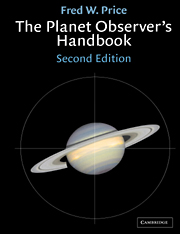Book contents
- Frontmatter
- Contents
- Foreword
- Preface
- Acknowledgements
- Abbreviations used in this book
- Introduction: Why observe the planets?
- 1 The Solar System
- 2 The celestial sphere
- 3 Telescopes and accessories
- 4 The atmosphere and seeing
- 5 Mercury
- 6 Venus
- 7 Mars
- 8 The minor planets (asteroids)
- 9 Jupiter
- 10 Saturn
- 11 Uranus
- 12 Neptune
- 13 Pluto
- 14 Constructing maps and planispheres
- 15 Planetary photography and videography
- 16 Photoelectric photometry of the minor planets, planets and their satellites
- Appendix: Milestones in Solar System exploration
- Name index
- Subject index
5 - Mercury
Published online by Cambridge University Press: 05 August 2012
- Frontmatter
- Contents
- Foreword
- Preface
- Acknowledgements
- Abbreviations used in this book
- Introduction: Why observe the planets?
- 1 The Solar System
- 2 The celestial sphere
- 3 Telescopes and accessories
- 4 The atmosphere and seeing
- 5 Mercury
- 6 Venus
- 7 Mars
- 8 The minor planets (asteroids)
- 9 Jupiter
- 10 Saturn
- 11 Uranus
- 12 Neptune
- 13 Pluto
- 14 Constructing maps and planispheres
- 15 Planetary photography and videography
- 16 Photoelectric photometry of the minor planets, planets and their satellites
- Appendix: Milestones in Solar System exploration
- Name index
- Subject index
Summary
General
Mercury, the first of the two ‘inferior’ planets, is the nearest planet to the sun and has a diameter of 3010 miles (4843 km) which is slightly more than one third of the Earth's diameter (fig. 5.1). Its mean distance from the sun is 36.0 million miles (57.9 million km) but it varies from 28.6 million miles (46.0 million km) at perihelion to 43.4 million miles (69.8 million km) at aphelion, owing to the great orbital eccentricity of 0.206 which is exceeded only by the orbital eccentricities of Pluto and several of the asteroids. This means that the sun is 7.5 million miles (11.9 million km) from the centre of Mercury's orbit. Owing to Mercury's nearness to the sun, its orbital speed is greater than that of any other planet, varying from a maximum of about 35 miles (56.3 km) per second when nearest and about 23 miles (37.0 km) per second when farthest from the sun. Mercury has no satellites.
Because it is an inner planet Mercury exhibits phases like our moon (fig. 5.2). It is ‘full’ at superior conjunction when on the opposite side of the sun to us, roughly half-moon shaped at its elongations, i.e., when at its greatest apparent angular distance from the sun on either side and ‘new’ when at inferior conjunction when between us and the sun.
- Type
- Chapter
- Information
- The Planet Observer's Handbook , pp. 73 - 101Publisher: Cambridge University PressPrint publication year: 2000



